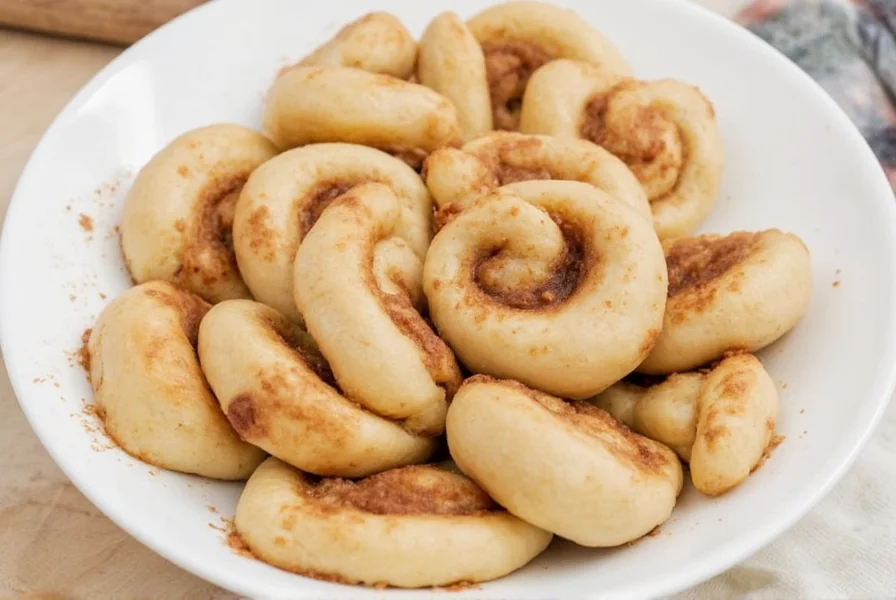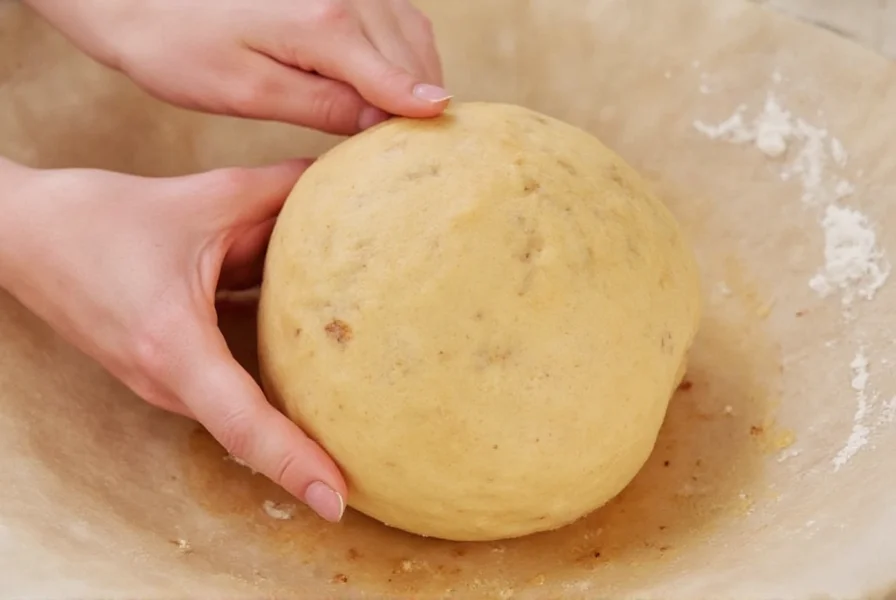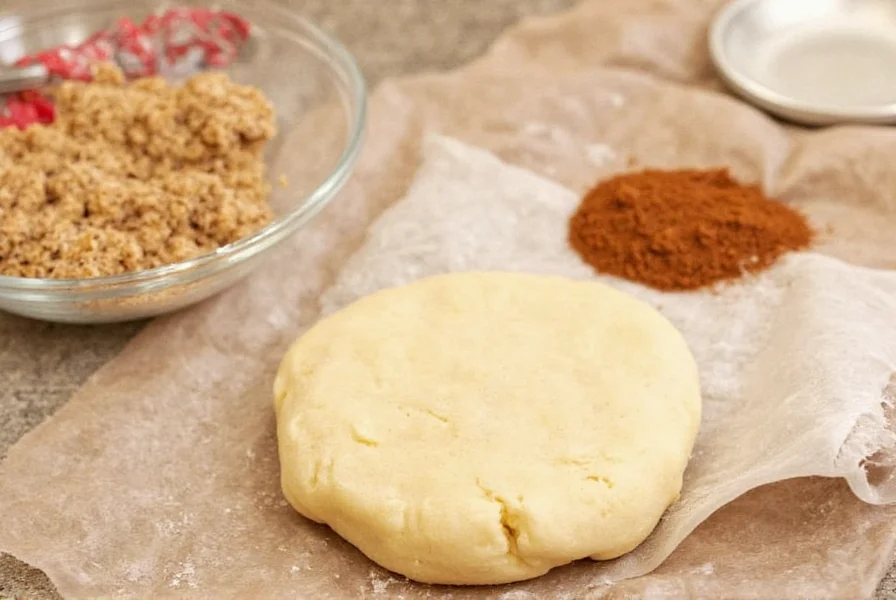Creating perfect cinnamon bun dough requires understanding the delicate balance of ingredients and techniques that transform simple components into pillowy-soft pastries with that signature swirl. Whether you're a beginner baker or looking to refine your technique, mastering this foundational dough is essential for achieving bakery-quality results at home.
The Science Behind Perfect Cinnamon Bun Dough
Unlike basic bread dough, cinnamon bun dough contains higher fat and sugar content, which affects gluten development and yeast activity. The ideal formulation typically includes:
| Ingredient | Function in Dough | Optimal Ratio |
|---|---|---|
| All-purpose or bread flour | Provides gluten structure | 450-500g per batch |
| Unsalted butter | Creates tenderness and flavor | 85-115g (softened) |
| Granulated sugar | Feeds yeast, adds sweetness | 60-85g |
| Active dry or instant yeast | Leavening agent | 7-10g |
| Whole milk or buttermilk | Hydration and richness | 220-250ml (warm) |
Step-by-Step Cinnamon Bun Dough Preparation
The process for making exceptional homemade cinnamon bun dough involves several critical stages that determine the final texture and flavor:
Mixing and Kneading Techniques
Begin by activating your yeast in warm milk (105-110°F) with a small amount of sugar. After 5-10 minutes, when the mixture becomes frothy, combine it with the remaining ingredients. The dough should initially feel slightly sticky but become smooth and elastic after 8-10 minutes of kneading. Proper gluten development is crucial for that perfect pull-apart texture in your cinnamon rolls.

First Rise: Temperature Matters
The ideal rising environment for cinnamon bun dough is warm (75-80°F) with moderate humidity. Most recipes require 1-1.5 hours for the dough to double in size. Rushing this process by using excessive heat can kill the yeast and compromise flavor development. For enhanced flavor complexity, consider a slow, cold rise in the refrigerator overnight—a technique professional bakers use for superior cinnamon roll dough texture.
Rolling and Filling: The Critical Stage
After the first rise, gently deflate the dough and roll it into a rectangle approximately 16x12 inches. The thickness should be uniform—about ¼ inch—to ensure even baking. Spread softened butter across the surface before applying your cinnamon-sugar mixture (typically ¾ cup sugar to 2-3 tablespoons cinnamon). This butter layer creates steam during baking, contributing to that distinctive flaky separation between dough layers.
Common Cinnamon Bun Dough Problems and Solutions
Even experienced bakers encounter issues with cinnamon roll dough. Understanding these common problems helps troubleshoot effectively:
Dough Won't Rise Properly
If your yeast dough for cinnamon buns fails to rise adequately, check these factors:
- Yeast viability: Test yeast in warm liquid with sugar before incorporating into dough
- Temperature: Cold ingredients or environment slows yeast activity
- Salt contact: Ensure salt doesn't directly contact yeast during mixing
- Fat content: Excessive butter can inhibit yeast if added too early
Sticky or Dense Texture Issues
For soft cinnamon bun dough that isn't gummy or dense:
- Avoid adding too much flour during kneading—stickiness should decrease as gluten develops
- Ensure proper rising time; under-proofed dough remains dense
- Maintain optimal baking temperature (350-375°F) for even cooking
- Allow proper cooling time before frosting to prevent sogginess
Advanced Techniques for Exceptional Results
Professional bakers use several techniques to elevate their cinnamon roll dough beyond basic recipes:
Tangzhong Method for Extended Freshness
Incorporating a cooked flour-water paste (tangzhong) into your dough significantly improves moisture retention. For a standard batch, cook 3 tablespoons flour with ½ cup milk until thickened, then cool before adding to your other ingredients. This technique creates an exceptionally soft cinnamon bun dough that stays fresh longer without becoming gummy.
Overnight Refrigeration for Flavor Development
After preparing your dough, place it in a greased container and refrigerate for 8-12 hours. The slow fermentation enhances flavor complexity while making the dough easier to handle. When ready to bake, remove from refrigerator, shape your buns, and allow 2-3 hours for the final rise at room temperature before baking.

Storage and Make-Ahead Options
Proper storage techniques ensure you can enjoy fresh cinnamon buns on your schedule:
- Refrigerated dough: Shaped but unbaked buns can stay in the refrigerator for up to 24 hours before baking
- Freezing options: Fully baked and cooled buns freeze well for up to 3 months; unbaked shaped buns can be frozen on a baking sheet then transferred to freezer bags
- Thawing method: For best results, thaw frozen unbaked buns in the refrigerator overnight, then allow 2-3 hours at room temperature before baking
Ingredient Substitutions for Dietary Needs
While traditional cinnamon bun dough relies on specific ingredients, thoughtful substitutions can accommodate various dietary requirements without sacrificing quality:
- Dairy-free option: Substitute plant-based milk and vegan butter in equal amounts
- Gluten-free adaptation: Use a quality gluten-free flour blend with xanthan gum (note: texture will differ from traditional dough)
- Egg replacement: For egg-free cinnamon roll dough, use ¼ cup unsweetened applesauce per egg
- Lower sugar version: Reduce sugar by 25% without significantly affecting yeast activity
Frequently Asked Questions
Can I use instant yeast instead of active dry yeast for cinnamon bun dough?
Yes, you can substitute instant yeast for active dry yeast in a 1:1 ratio. The primary difference is that instant yeast can be mixed directly with dry ingredients without pre-dissolving. When using instant yeast for cinnamon roll dough, you may notice slightly faster rising times—reduce the first rise by 15-20 minutes to prevent over-proofing.
Why does my cinnamon bun dough shrink when I roll it out?
Dough shrinkage typically occurs when gluten is over-tightened during rolling. This happens when the dough hasn't rested sufficiently after kneading or if you're applying too much pressure. For optimal results with yeast dough for cinnamon buns, let the dough rest for 10-15 minutes after the first rise before rolling. This relaxes the gluten, making the dough more pliable and less likely to retract.
How can I prevent my cinnamon buns from becoming too dark on the bottom?
To avoid over-browning on the bottom of your cinnamon rolls, use a light-colored metal baking pan instead of dark non-stick pans, which absorb more heat. Placing a second baking sheet on the rack below can also help shield the bottom from excessive heat. For cinnamon bun dough that maintains perfect golden color throughout, check your oven temperature with an independent thermometer—many ovens run hotter than their settings indicate.
What's the ideal internal temperature for fully baked cinnamon buns?
Properly baked cinnamon buns should reach an internal temperature of 190-200°F (88-93°C) when measured with an instant-read thermometer inserted into the center of a bun. This temperature range ensures the dough is fully cooked without becoming dry. For the best soft cinnamon bun dough texture, remove the buns from the oven when they reach 195°F, as carryover cooking will continue to raise the temperature slightly during cooling.
Can I make cinnamon bun dough without eggs?
Absolutely. For egg-free cinnamon roll dough, substitute each egg with ¼ cup unsweetened applesauce or a commercial egg replacer. The texture will be slightly less rich but still delicious. You may need to adjust liquid content by 1-2 tablespoons as applesauce adds moisture. Many traditional Scandinavian cinnamon bun recipes actually omit eggs, resulting in a lighter, more bread-like texture that still delivers excellent flavor and spiral definition.











 浙公网安备
33010002000092号
浙公网安备
33010002000092号 浙B2-20120091-4
浙B2-20120091-4